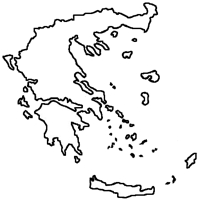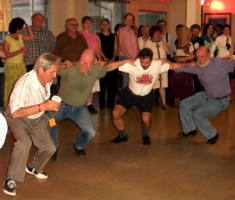
|
The Society of Folk Dance Historians (SFDH)
Greek Dance
[
Home |
About |
Encyclopedia | CLICK AN IMAGE TO ENLARGE |

|
 The age of mythology in Greece at its first awakening was ushered in to the rhythm of the dance. In all ancient cities, at all religious festivals, the "dance was set." In those days, dance was religious; it was prayer and worship, an act of faith. They could be referred to as "folk dances," as they were participated in by the common folk, or a community of people who sought to express common feelings among them.
The age of mythology in Greece at its first awakening was ushered in to the rhythm of the dance. In all ancient cities, at all religious festivals, the "dance was set." In those days, dance was religious; it was prayer and worship, an act of faith. They could be referred to as "folk dances," as they were participated in by the common folk, or a community of people who sought to express common feelings among them.
This feeling presisted among the Greeks throughout the ages, from the times of the polytheistic religion to the monotheism of Christianity. The Greeks in their awareness of the celebration of life and the splendor and joy in it that sought its due expression continued their dances, not as part of the ritual anymore in the temples, but outside the church courtyards.
In the ensuing years when Greece was suppressed by Ottoman rule for over 400 years, the Greeks were forced to become introspective about their identity. In their dire effort of restraining, they reached hard to strive to maintain their form of expression, which depicted the essence of their heritage. Therefore, dance, the unspoken language, became a very vital source of communication in a society that felt burdened. Movement took on a new, significant role, as the feelings related within were of utmost importance to a people who needed to seek some identity with his fellow man. The power of non-verbal communication existed in man throughout the ages, and its earthshaking viability can be seen even today in a time when progress, science, and the written and spoken word have dominated all our communication media.
 Dance was never restricted to any group of people nor certainly to any age as, in the words of the poet, Anacreon, "When old age leads the dance, his white hair only tells of his years – but youth is in his heart." The poise, the steps, the motions of the ancient dancers are the same today in Greek folk dances and are executed with the same fervor and passion as those legendary tales and heroes that were sung and danced to exalt the spirits of the ancients. No doubt that the same kind of communion and happiness that was exuded from a Syrto in Homer's time can still be extracted today. This kind of circling where people are brought together, with the undulating movements of to and fro, this progression and digression is seen in life itself. The strong bonds felt by people holding hands in a circle gives one the sense and strength of belonging to the human race, and where negatives and hostile thoughts are minimized and the feeling of abandon relents into the flow of rhythm together.
Dance was never restricted to any group of people nor certainly to any age as, in the words of the poet, Anacreon, "When old age leads the dance, his white hair only tells of his years – but youth is in his heart." The poise, the steps, the motions of the ancient dancers are the same today in Greek folk dances and are executed with the same fervor and passion as those legendary tales and heroes that were sung and danced to exalt the spirits of the ancients. No doubt that the same kind of communion and happiness that was exuded from a Syrto in Homer's time can still be extracted today. This kind of circling where people are brought together, with the undulating movements of to and fro, this progression and digression is seen in life itself. The strong bonds felt by people holding hands in a circle gives one the sense and strength of belonging to the human race, and where negatives and hostile thoughts are minimized and the feeling of abandon relents into the flow of rhythm together.
Specific ideas that are expressed in the folk dance such as the "Tsamiko" took on striking importance at different times in history, as with the cause of Greek Independence in 1821 – the rhythm of the dance strongly identified with the heroic beat – was utilized and dramatized to recreate aspects of heroism which obviously were necessary for a people under that particular struggle. The 6/8 meter found in ancient poetry gives us enough reason to believe that this form persisted throughout the ages, for when man seeks to express heroic antics, he reaches deep not only into his own consciousness, but also into the depths of his ancestral roots to solidify his identity. In seeking to recreate this dance in our times and to find any relevance for it, we must also need to want to express some form of heroism in order to validate the dance experience. What then in our society defeats us which makes us want to raise above victorious?
When we read about classical Greece and try to find references to the dance as of then, we find such comments as "Rhea, daughter of Earth, taught the dance to her priests, the Corybants, and the Kouetes in Crete. Youths and maidens at religious rites in Knossos welcomed the coming of spring with dance. Maidens danced at the Panathenaic festival for the Goddess, Athens." Such comments are constantly being made either by scholars or by those studying any of the writings, or deciphering whatever record has remained in stone, pottery, etc. from that period in history. It is believed that by the classical age, more than 200 dances were known. In examining frescoes and vase paintings or bas-reliefs, we can see definitely striking resemblances between ancient dances and the folk dances of the Greeks today. When we say resemblances, we mean that there are aspects of costume, gestures and poses, and hand holds, as well as positions that are similar. Put all of this together with aspects of the culture and song and dance as well as the language, and we can determine that there is a definite continuity of the culture, and that the invaders and those others passing through left very little influence. Dances depicted in groups or in couples were called Epilenia, and they expressed the movements of the collection of, and the pressing of, grapes. The Anthema was danced by groups at popular fests in honor of the coming of spring. The historian Lucian describes a dance called Ormos, meaning necklace, or dancers linked together as in contemporary folk dances.
The passion of the dance has been preserved by the Greeks through the ages and the dance still plays a part, an important one, in many national, social, and domestic affairs. A leader, linked by a handkerchief in a circle, dances with a flexible movement, turning, bending, leaping, and beating his heels. Whereas the men display agility and virility, the women dance "demurely" with downcast eyes. This great force of expression entertains a great popularity today, not as a revived art, but rather one that has endured from a deep heritage and a great civilization.
DOCUMENTS
- Athan Karras, an article.
- Greece, a country.
Used with permission of the author.
Printed in Folk Dance Scene, March 1980.
This page © 2018 by Ron Houston.
Please do not copy any part of this page without including this copyright notice.
Please do not copy small portions out of context.
Please do not copy large portions without permission from Ron Houston.